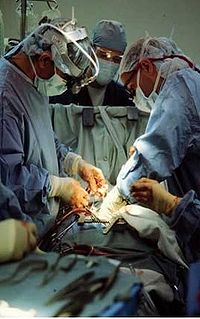
Photo from wikipedia
The cornerstone of curative care for esophageal cancer is neoadjuvant chemoradiotherapy followed by esophagectomy with a radical lymphadenectomy. An esophagectomy is a major and complex surgical procedure and is often… Click to show full abstract
The cornerstone of curative care for esophageal cancer is neoadjuvant chemoradiotherapy followed by esophagectomy with a radical lymphadenectomy. An esophagectomy is a major and complex surgical procedure and is often followed by postoperative morbidity, especially pulmonary complications. These complications may lead to an increase in hospital stay, intensive care unit admission rate and mortality. Therefore, perioperative strategies to reduce these complications have been investigated and implemented in clinical practice. In this review we highlight the influence of minimally invasive surgery, postoperative pain management, early identification of complications and the usage of uniform definitions on (pulmonary) complications after esophagectomy. Finally, we will discuss some future perspectives.
Journal Title: Journal of thoracic disease
Year Published: 2019
Link to full text (if available)
Share on Social Media: Sign Up to like & get
recommendations!